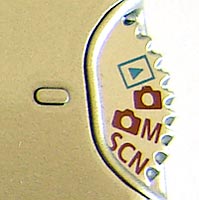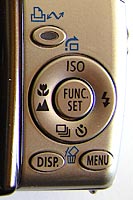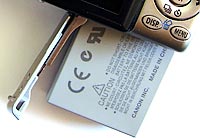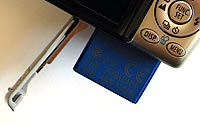Canon Digital IXUS 800 IS Review
Review Date: August 15th 2006
Author: Gavin Stoker
Leave a comment about this Review
|
Ease of Use
For anyone familiar with the IXUS 65, which sits just below the flagship Canon Digital IXUS 800 IS in the range, there are immediate, obvious design similarities � but a few key differences also, including here optical image stabilisation and a better 4x optical zoom range. While the 800 IS lacks the 65�s funky iPod-style dial at the back, it�s equally palm sized and oozes style, its grey metal faceplate smooth to the touch, while, with 3.7v lithium ion battery and supplied 16MB SD card inserted, the camera feels reassuringly weighty in the hand.
Overall build quality is high. A smaller 2.5-inch LCD dominates the rear, above which it�s a surprise to discover a largely superfluous optical viewfinder. A tapered curve to one side of the body (or in Canon�s words a �perpetual curve�) ensures a slender finish that will compete with the likes of Nikon�s curvaceous Coolpix S5 and S6. Atop the camera a zoom lever ergonomically encircles the shutter button, affording quick operation from the off. Unfortunately, as with most slim-line compacts, attendant controls have been cast in miniature, suitable only really for fingertip operation. These include a on/off button top right of the LCD at the rear, plus a slightly recessed bottle-top style mode wheel, far right, affording clockwise access to playback, full auto capture, manual capture, 16 shooting modes (including optimized settings for, most interestingly, underwater and the gimmicky Colour Swap) plus video clips.
Halfway down the back you have a one-touch button for direct printing (the camera is Pictbridge compatible) plus a four-way control dial that doubles up as a means of selecting ISO sensitivity (maxing out at ISO800 here), macro or landscape settings, the regular flash options, continuous shooting and self timer. At the centre of the dial is the self-explanatory function set button, and below this a pair of further buttons for activating on-screen display and accessing menu screens. Despite the small controls, everything seems logically placed on the IXUS 800 IS: for example, with your forefinger resting on the main shutter button, your thumb is free to turn the mode dial below, or drop down to effect changes via the function button encircled by the four-way dial.
| Mode Dial | The Major Controls |
 |
 |
Upon powering up the camera the LCD bursts into life and the 4x optical zoom extends from storage flush to the body, resting at maximum wide-angle setting. Key settings such as flash, ISO, metering, resolution and an image counter are automatically and clearly displayed as a default. A further press of the dedicated menu button will bring up a three-folder selection, instantly familiar to any IXUS user. In auto mode, the first, denoted by a camera icon, includes options to activate the likes of self timer, AF-assist beam, digital zoom and more importantly here, image stabilisation. Manual mode includes all the above features, but adds a long shutter option.
Optical image stabilisation is obviously one of the 800�s chief selling points. It can be set to continuous, shoot only (ie when you actually press the shutter), deactivated, or used for panning shots. In our tests, shoot-only IS provided more consistent results than continuous, while, to test the feature to its limit, attempting a panning shot out of the window of a moving vehicle unfortunately resulted in a blurred mess. Though IS isn�t perfect, you�ll gain a higher percentage of usable shots with it than without � and, in fact, I got sharper shots with greater consistency in low light than I achieved with Fuji�s non stabilized but higher ISO F30.
The second menu folder, denoted by a familiar spanner and mallet icon, provides all the basic set up options � the most noteworthy being manual adjustment of screen brightness, memory formatting, and the option to revert all settings to default. The third and final folder is less essential, allowing users to change start up images and operational sounds to suit tastes. Once again, these settings are mirrored in manual mode, scene mode and, to a lesser extent, video mode. Usefully image stabilization is accessible in the latter, though frustratingly the optical zoom is disabled once filming has commenced; so make sure you frame up accurately beforehand. Fortunately, the zoom lever is responsive and its operation fluid, and, as our karaoke test clips show, sound and frame rate isn�t bad.
In all shooting modes, the essentials of resolution and file size are pre-determined with a press of the separate function button. Manual mode adds digital macro, stitch assist (to marry up panoramic shots), plus +/- 2EV exposure adjustment, the tweaking of white balance (though on full auto the IXUS makes a decent fist of it) plus evaluative, centre-weighted or spot metering. In this mode you also find Canon�s �My Colors� options, which e include the ability to shoot in vivid colour, sepia or black and white, plus darken or lighten skin tone and tweak RGB. Interestingly, for purists there�s also a positive film option. In truth, that�s just about enough features to save anyone who�s progressed beyond point and shoot getting easily bored.
| Battery Compartment | Memory Card Compartment |
 |
 |
Used indoors as a viewfinder, utilizing only natural light, the wide view LCD display is clear and free from ghosting or other artifacts. Its stark clarity is maintained outdoors, with sunlight unproblematic. At nighttime though it really comes into its own, with a resolution at 173k pixels proving sufficient to enlarge portions of the picture and check both for critical focus and any image noise.
Thanks in part to Canon�s internal DIGIC II processor, as utilized by its EOS D-SLRs, the 800 IS is no slouch in the speed stakes. Powering up takes just over a second, while committing a full 6MP resolution, maximum quality JPEG to memory (as you�d expect, there�s no TIFF or RAW option) takes merely a blink of an eye (no flash). Any shutter delay is indiscernible, once focus and exposure has been pre-determined with a half press of the shutter button. Overall, operational speed impresses, suggesting the IXUS 800 IS as a decent backup snapshot model for any D-SLR owner who occasionally wants something more portable � perhaps when heading out for a night on the town. Battery life is also pretty good; I was using the camera across a two-week holiday period, utilizing the LCD for all composition and review, and it was still going strong when I got home.
In playback mode, you get a menu screen containing four folders of options to choose from. In the first, the My Colors effects menu again rears its head, allowing you to affect change to an image retrospectively. The feature doesn't overwrite an original, merely saves the new image alongside it. You also get the more expected features, such as slideshow, with a choice of just two transitional effects, plus the ability to add a sound memo to a file, rotate, protect or erase images. The second playback folder allows the earmarking of images for print and controls print settings, while the third and fourth folder are the standard set up and start up options. Again, the camera responds pretty much instantaneously to any selection.
|
![]() PhotographyBLOG
is a member of the DIWA
organisation. Our test results for the Canon Digital IXUS
800 IS have been submitted to DIWA
for comparison with test results for different samples of
the same camera model supplied by other DIWA
member sites.
PhotographyBLOG
is a member of the DIWA
organisation. Our test results for the Canon Digital IXUS
800 IS have been submitted to DIWA
for comparison with test results for different samples of
the same camera model supplied by other DIWA
member sites.
